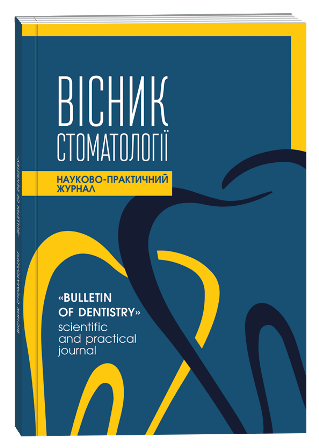EFFECT OF MODELING DELAYED AND EARLY TEETHING ON BIOCHEMICAL PARAMETERS OF JAW PULP AND BONE TISSUE IN EXPERIMENTAL ANIMALS
DOI:
https://doi.org/10.35220/2078-8916-2024-51-1.5Keywords:
teething, antibiotics, thyroid hormones, enzymes.Abstract
Purpose of the study. Study of changes in the activity of rat pulp and jaw bone enzymes in models of delayed and early teething. Materials and methods. Experimental studies were performed on 20 white laboratory female rats and 37 pups that were born to them. Depending on the drugs used, the animals were divided into 4 Groups: 1. intact (vivarium diet); 2. vivarium diet + L – thyroxine at a dose of 10 mg/kg; 3.vivarium diet + antibiotics (cefoperazone 180 mg/kg – pregnancy, amoxiclav 135 mg/kg – lactation); 4. vivarium diet + Mercazolil – (20 mg/kg – pregnancy), (50 mg/kg – lactation). Starting from the first day of Drug Administration, males were hooked up to females. In rats of the second group, the state of experimental hyperthyroidism was modeled by daily oral administration of L-thyroxine (Berlin-Chemi, Germany) at a dose of 10 mg/kg of body weight daily during pregnancy and lactation. The administration of antibiotics in the 3rd group of rats was carried out according to the following scheme: two courses of cefoperazone, which was administered orally at a dose of 180 mg/kg from the first day of the experiment for 6 days. Experimental hypothyroidism was modeled in Group 4 rats by oral administration of Mercazolil. During pregnancy, rats received the drug at a dose of 20 mg/kg daily, during lactation the dose was increased to 50 mg/ kg. Further studies were conducted on rat pups that were born to females receiving various drugs. Research results. From the data obtained by us, it can be seen that the level of activity of lysozyme – an indicator of non-specific antimicrobial protection, in the pulp of incisors of the 2nd Group significantly decreased by 91.3 % (P < 0.001), in the 3rd-by 99.4 % (P < 0.001) relative to the Intact Group, and in the 4th – was absent altogether. This indicates a negative effect on the lysozyme-synthesizing function of animal tooth pulp and practically suppresses non-specific immunity and antimicrobial protection. Conclusions. The results of the conducted studies indicate a violation of the mineralizing function of the pulp with a predominance of odontoclast activity in rats when modeling delayed and early teething. The results obtained indicate inhibition of bone formation processes in the jaws of animals when modeling delayed and early teething.
References
Мельник В. С., Горзов Л. Ф., Зомбор К. В. Терміни формування тимчасового і постійного прикусу в дітей Ужгорода. Український стоматологічний альманах. 2018. №(1). С. 60-63.
Smaglyuk L.V., Chukhray N.L., Bezvushko E.V., Miskiv A.L., Shpotyuk O.O. The relationship of malocclusions with the eruption time of permanent teeth in children living in different climatic and geographical conditions. Світ медицини та біології. 2020. № 16(1 (71). Р. 132-136.
Міськів А. Л., Безвушко Е. В. Терміни прорізування постійних зубів у ранньому змінному прикусі у дітей Львівської області. Вісник проблем біології і медицини. 2015. № 4 (1). С. 300-303.
Brecher E.A., Lewis C.W. Infant Oral Health. Pediatr Clin North Am. 2018. № 65(5). Р. 909-921. doi: 10.1016/j.pcl.2018.05.016. PMID: 30213353.
Годованець О.І., Рожко М.М. Особливості становлення зубощелепної системи у дітей із дифузним нетоксичним зобом. Вісник проблем біології і медицини. 2015. № 2(2). С. 37-40.
Kreiborg S., Jensen B.L. Tooth formation and eruption – lessons learnt from cleidocranial dysplasia. Eur J Oral Sci. 2018. № 126(1). Р. 72-80. doi: 10.1111/ eos.12418









